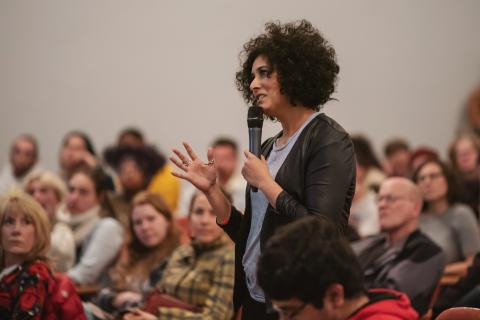
By Jannett Matusiak
Navigating social media can be as daunting as driving in Boston. There’s lots of noise, no clear signage pointing you in the right direction, and a wrong move could prove regretful.
Like most writers, I have social media accounts but am not always sure how to promote my work without being one of those people. Should I follow a particular etiquette and keep a separate account for my personal life? What is best practice? That’s why I couldn’t wait to sit in on the brown bag lunch panel Social Media for Writers with Monika Woods from InkWell Management and authors Eleanor Brown, Jenny Shank, and Ron Doyle. I hoped they’d dish out some good nuggets. And they did.
[caption id="attachment_6171" align="alignright" width="150"] Every writer looking to get published needs to create a community of interested readers. Start now.[/caption]
Every writer looking to get published needs to create a community of interested readers. Start now.[/caption]
Every writer looking to get published needs to create a platform—a community of interested readers—to help promote their book. It takes time to build a community. Start now.
Being on Facebook, Twitter, Goodreads, Tumblr, etc… is not only a good way to share your own writer-ly happenings but a great way to share news from other writers. In fact, this is one of the main ways you can avoid being a Facebook casualty: interact with others. Nobody wants to be bombarded with robotic me me me posts. Doyle suggested a ratio of 80 percent talking about something else and 20 percent about yourself, a stat that both introverts and extroverts can love. Ultimately you have to ask yourself, what am I offering my followers?
Share posts that promote other people’s work you love, comment on literary events, like pages of your favorite independent bookstores and literary journals. Is there a writer you admire online? What are they doing on their profile?
One pitfall of having a separate author page is that Facebook tightly controls how many people can see your posts without paying to advertise. Word is that the price tag is affordable, but you may reach a larger audience in your private account.
“Create clear boundaries for yourself,” said Brown, New York Times bestselling author of The Weird Sisters. Do you want to share personal photos? Do you want to friend everyone? Think about what your limits are. You may be faced with building separate friend groups if your book projects reach disparate audiences. Brown encouraged us to create lists on Twitter and Facebook to help manage whom you follow and how you release information.
Even with a clear sense of what you want to share, it might not always be easy to control. Boundaries get blurred easily. Do what you can to protect your privacy. There are ways to share some of your private life without letting 1,000 strangers through your front door. Figure out what’s too personal.
One strategy for privacy is to choose one social media platform for your public persona, like Monika Woods from InkWell Management, who opts to use Twitter to reach larger audiences but keeps Facebook more private.
Jenny Shank, author of The Ringer, shared fun hashtags to follow on Twitter as a way of connecting with other writers: #sundaysentence (tweet your favorite sentence that you’re reading that day) and #smallfates by Teju Cole who created little stories from story headlines in newspapers.
Other Tips:
- Don’t over-tweet. You’ll just become noise someone will unfollow.
- Get a website.
- Give yourself a time limit on social media. Try a half hour in the morning and a half hour at night. After all, shouldn’t you be spending more time writing at your desk?

